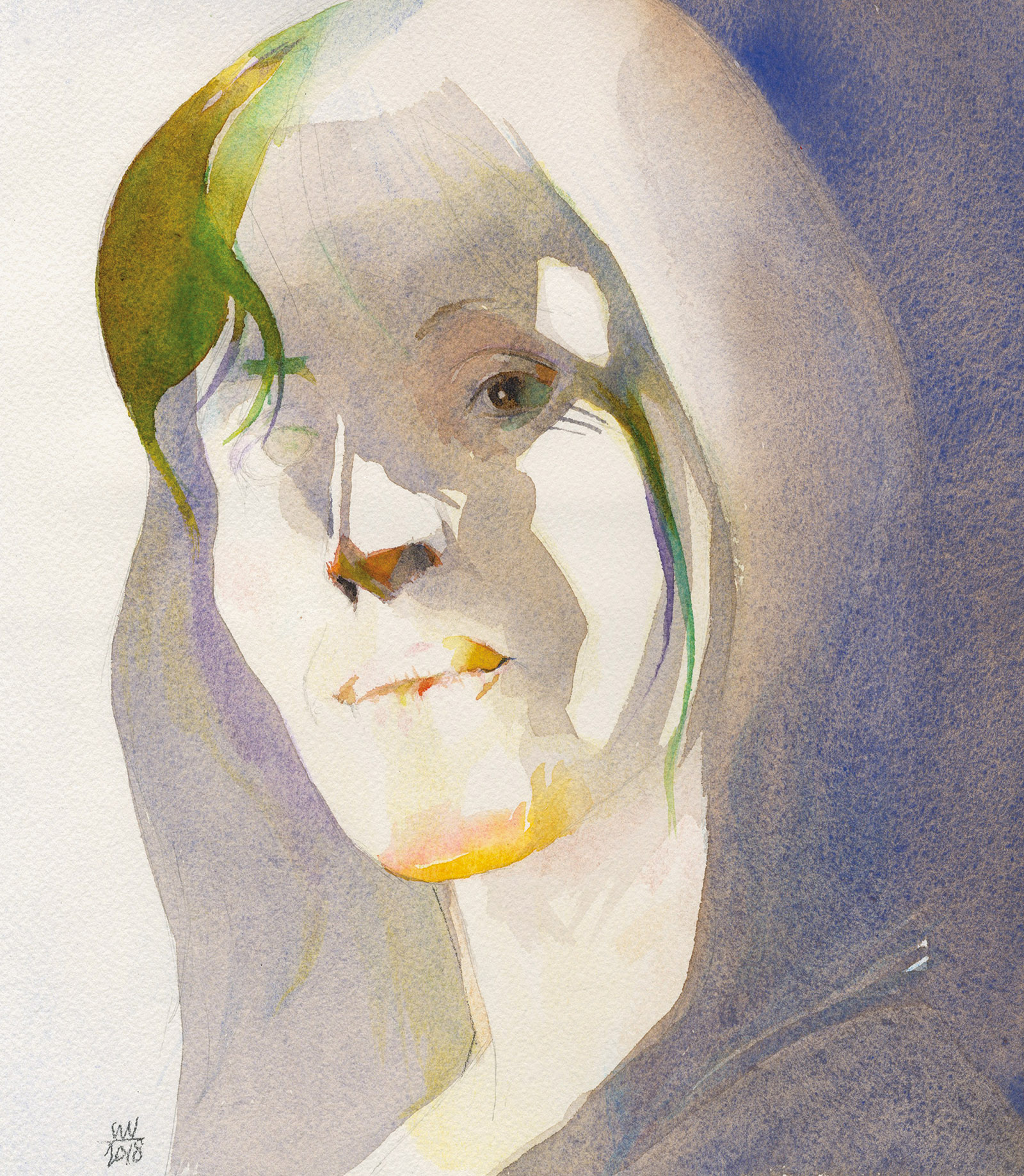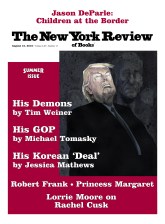In introductory studio art classes students are often assigned a negative-space drawing—that is, they are asked to draw everything surrounding a figure, filling up the page, until the blank shape of the figure emerges. This has been Rachel Cusk’s technique in her last trio of novels—a trio referred to appropriately as the Outline trilogy—and it is a little puzzling that more people haven’t thought to write novels in this manner before. Perhaps we go to fiction for the solitary inner life of one character and her actions against the confining tenets and structures of her society (though Cusk’s trilogy manages this as well) rather than for everything surrounding her—in this case, linked and paraphrased soliloquies of secondary, even tertiary, characters upstaging and downstaging the ostensible protagonist. This is not a cinematic way of writing a novel but it is theatrical, with sudden arias and contiguous monologues reminiscent of the plays of Brian Friel.
As in a negative-space drawing, the trilogy’s narrator—a writer named Faye (otherworldly as in fey; defiant as in fie)—is a silhouette, rapt and wrapped, her form determined by the purposeful chat of others, which hovers, adheres, and sculpts. She is the prompt and master of ceremonies for other narrators, who in turn sometimes tell stories with additional narrators nested within them like Russian dolls (or Russian short stories, which are prone to framed and embedded narrations). That Cusk has constructed her novels in this radical manner seems both perverse and inventive and has caught the attention of many other writers. Despite comparisons, her work is not the autofiction of Karl Ove Knausgaard and Sheila Heti, whose own voices and personalities cram their pages; nor is it the meditative flâneurie of W.G. Sebald or Teju Cole; it is something more peculiar and thrilling and Cusk’s own.
The concentrated, flinty nature of Cusk’s mind (a fellow admirer and I often refer to her, in pseudo-jazz-intimacy, simply as “Rachel,” though we have never met her and haven’t the flimsiest intention of trying to do so) ensures that authorial intelligence is burned into the syntax of every line, despite the cloaked narrator in the foreground. Even if they technically belong to fictional others, the voices, with their stories of familial upheaval, traps, escapes to dubious safety, or dull drift, are chosen and arranged by Cusk as both reflections and arguments concerning life’s dissolutions and reconstructions. What runs through her trilogy is a coolly abstracted consciousness organizing all the stories—one that is alert to the mendacity and (as the trilogy suggests, if they are any good) the cruelty in stories (in a culture that glibly claims to value them). It is like reading the best kind of philosophy—steely, searching, brisk.
Outline, the trilogy’s first volume, begins at a meeting between the recently divorced Faye and a London billionaire interested in starting a literary magazine, then moves quickly to the passenger beside her on a flight to Greece, where she is headed to teach a summer workshop. Her neighbor (the word “neighbor,” so crucial in theological texts, is a motif throughout the trilogy) bursts forth with a long story of marital wreckage. The pronouns slide between first and third person, and we see that the glass behind which Faye sits impassively and listens is sometimes a window and sometimes a mirror.
Quotation marks come and go indifferently, once in a while blurring the identity of the speaker. We see that we are experiencing a presentation: a midair collusion of storytellers and pronouncers. Faye’s voice and those of the characters she encounters sometimes merge—and that is the point. However underperforming our lives may be, the stories of them are always performances. Faye makes statements that seem to announce the book’s narrative strategy: “I was beginning to see my own fears and desires manifested outside myself, was beginning to see in other people’s lives a commentary on my own.”
When she asks her students to write a story about an animal (Cusk is sensitive to the predicaments of animals, especially dogs, and her books, even those before Outline, abound with such tales), we can see that this is how she sees fictional characters—as pets: “They watch us living; they prove that we are real; through them, we access the story of ourselves. In our interactions with them we—not they—are shown to be what we are.” They are guinea pigs, of a sort, and as for actual guinea pigs, Faye describes some “who lived in a hutch out in the garden and whose matted corpses I had had to dig out with a shovel from where they had buried themselves in the straw.” Her characters are frightened and scrambling and often fatefully on the run.
Advertisement
On the ground but outside the classroom, Faye encounters an Irish writer, an Athenian publisher, and a glamorous feminist novelist just back from a book tour in Poland. All tell stories—through Faye—of disillusion, rupture, and homelessness. At one point the novelist just back from Poland gets out a pen and writes down what Faye has said as well. It is a quick amusing bit of dueling pens—writers encountering each other at professional meetings and not being able to stop gathering material.
Transit, the second novel in the trilogy, may be the most dramatically appealing. It begins intriguingly with an astrologer’s e-mail:
She wished me to know that a major transit was due to occur shortly in my sky…. For a small fee she would share it with me and enable me to turn it to my advantage….
She understood that many people closed their minds to the meaning of the sky above their heads, but she firmly believed I was not one of those people…. She knew that I had suffered sufficiently to begin asking certain questions…. What the planets offer, she said, is nothing less than the chance to regain faith in the grandeur of the human.
Even if the message is ostensibly generated by an algorithm, it flies off the page as Cusk’s:
She hoped I would forgive her for contacting me in this way and for speaking so openly…. She felt a strong personal connection between us that had encouraged her to say what was in her heart.
Faye is the metaphysical magnet for even online versions of her own thoughts. Look to the skies: she is a collapsed star of bent time and squeezed space; stories fly in from other galaxies. (A galaxy dragged into a black hole creates a brilliance scientists call a “blazar.” Just saying.) Transit is also the funniest novel in the trilogy and features more characters outside the literary world—a hairdresser named Dale, an English builder, a self-taught Polish architect (who designed for himself a glass house in the woods, to his father’s raucous derision), an Albanian builder, an ex-beau, a romantic acquaintance, a young female student who believes she is the painter Marsden Hartley. Transit is about structural transitions and the vulnerable refurbishing and dislodging that occurs during them, whether it be a new hair color or a gut renovation of the home (the pun is almost too much to bear).
There are also, as ever, professional writers. Despite their mansplaining they are mostly weary and benign. They, too, voice Cusk’s aesthetic concerns. Louis, who bears some resemblance to Knausgaard, is presented in this fashion:
He had succeeded in writing a book simply by virtue of the fact, as he had already said, that while writing he had believed himself to be unknown…. He wished only to return to that state in which, uniquely in his experience, he had been capable of absolute honesty, but by using writing as the forum for it, he had also ensured that writing was a place he would never be able to go back to. Like a dog that shits in his own bed, he said, turning and looking directly, for the first time, at me.
Transit is also slightly more conventional in its construction: Faye has more lines and the dialogue more volleys. And who wouldn’t love a novel that ends with a disastrous dinner party, the hostess’s dress ripped to the waist and the children in tears at the poignantly roasted chickens? But in this volume Cusk introduces more openly the subject with which the trilogy concludes: what it is to be despised. Despised for being a woman, despised for one’s honesty, despised for being cast out of social convention, family, marriage, despised and culled from the herd: a deepened banishment of a solitary literary woman perhaps already destined to be despised. Faye’s student stares daggers at her. The festival chairman physically aggresses her. Her children phone her, weeping and accusing. In her new apartment Faye’s downstairs neighbors hate her the most vehemently—“a power of elemental negativity…so pure…that it almost passed back again into love. They were, in a way, like parents, crouched malevolently in the psyche of the house.” The Albanian builder wins the neighbors over by telling them he hates Faye too—and having made this alliance, his renovation of her place can proceed noisily without their continued complaining. But Faye suspects he has not lied.
When the novel contemplates rigid ideas of honesty, freedom, and justice, it is not without notes of Antigone and Cordelia, self-saboteurs who polished their virtue with the dustrag of vanity. Faye is alert to the price of being the heroine of one’s own story, its cost to knowledge both of the world and of the self, and thus her method in life is a winding, disciplined middle way:
Advertisement
It seemed to me that forgiveness only left you more vulnerable to what you couldn’t forgive. Francis of Assisi…had been disowned by his father, who had even taken him to court to sue him for the material outlay of parenthood, which at that point amounted to little more than the clothes on his back. St. Francis removed them there in court and returned them to him, and thereafter lived in a state that other people called innocence but that I viewed as utter nihilism.
Which brings us to the capstone of her trilogy, the recently published Kudos. It is set initially at a festival in Germany and then at a conference in an unnamed Mediterranean country which, due to its ragged economy, its conquistador past, and its jacaranda trees, appears to be Portugal. Like its predecessors, Kudos uses the interstices of the literary life, the between-book professional chores, the nonwriting time—festivals, fairs, panels, workshops, and promotion in foreign countries—as occasions. Such events are ordinarily thought of by writers as purgatorial junk—disposable, obligatory, irrelevant. Yet much can be shown to go on there. Surrounded by publicists, translators, editors, and sometimes fellow writers, Faye follows along taking mental notes. Usually, a writer on book tour is not a writer at all. As more than one writer has put it to journalists, Take a photo of me when I’m not writing and you are taking a picture of a ghost. Cusk has remarked that she is surprised, once it has been taken, even to see herself in a photograph.
But Faye is hardly a ghost. She remains to the bitter end the karaoke queen of rue. Her voice and the characters she encounters once again merge—she is the conductor of the lip-sync chorus—but one may feel that this last volume is both more fatigued by its strategies (a tedious solo by a German guide feels necessary only for its explanation of the volume’s title) and more harsh in its conclusions.
To the extent that these books have narrative suspense it lies in whether Faye, having embarked on the midlife referendum that is this trilogy, will reenter the problematic institution of marriage. (Leave or Remain does double duty by also underscoring a Brexit theme.) In her summing-up of the heroine’s plight in Janáček’s The Cunning Little Vixen, Faye worries the consequences of domestic captivity:
Her nature drives her to seek the wild, and one day she escapes the farmyard and finds her way back into the forest; but instead of feeling liberated she is terrified, for having lived in the farmyard most of her life she has forgotten how to be free.
In Kudos, another character treats her own body, she says, “like the family dog…. It’s never going to be free, if it even remembers what freedom is.”
In that tiny respect, Cusk’s project is that of an old-fashioned novel. But this is less a romantic plot point than one about structures and survival: not how should one live but how can one live. Perhaps Cusk has borrowed from The Decameron’s many-headed storytelling against the backdrop of a plague. A chorus made from many solos. A score akin to oratorio. “Annihilated perspective,” Cusk has called it.
Kudos begins with yet another confiding stranger on a plane; he is too tall for his seat, so Faye trades places with him (this is not mere niceness but surely an authorial joke about getting into character), giving him the aisle in which to sprawl. He cannot be contained. Once again, as in Outline, we are privy to a neighbor with a tale to tell, a novelist’s objet trouvé:
He had discovered the power and pleasure of reliving events with their sting removed. The skill, I saw, lay in skirting close enough to what appeared to be the truth without allowing what you actually felt about it to regain its power over you.
Though only forty-six years old he is a retired director of a global management company. His most recent trauma has been burying the family dog, and he still has dirt under his nails to display. It is a startling tale without simple meaning, and when Faye moves on to her other land-based storytellers, they too have stories of injury and death. She meets a publisher, a journalist, a festival guide, a translator. The Irish writer returns from Outline for a curtain call, older, thinner, and with a long disquisition on his new Fitbit.
In one of the more haunting scenes a Portuguese publicist named Paola (not a limerick!) takes Faye to see a small church destroyed by fire; she believes it has been returned by trauma to a kind of natural form, blackened and melted: “I find the sight of it extremely moving. The fact that it has been allowed to continue in its true state…when everything else around it has been replaced and cleaned up.” And here the analogy to Cusk’s narrative strategy is made even more explicit:
“In certain places where statues had obviously been, new lights had been installed which illuminated the empty spaces. These lights,” she said, “had the strange effect of making you see more in the empty space than you would have seen had it been filled with a statue. And so I knew,” she said, “that this spectacle was not the result of some monstrous neglect or misunderstanding but was the work of an artist.”
When they arrive the church is locked. Its haunting interior remains only within a story.
As for the marriage plot? Well, to the puzzlement of her divorced publicist and divorced translator, Faye has already remarried. These Portuguese women’s woeful tales of being self-proclaimed “outlaws”—outlaws even to their own mothers, who say such things as “Look at what all your equality has done for you—the men no longer respect you and can treat you like the dirt on their shoe”—cause Faye to say that she wishes to get the better of the laws by remaining within them. While she emotionally identifies with these outlaws, toasting each other with glasses of wine, Faye does not want to be one of them. Their pain is palpable, familiar, unsolvable. She has chosen once more to marry, to give it another go, to work from the inside of social structures rather than step away.
So in Kudos Faye’s feminism has surveyed the field and its more radical options and become reformist. (“Marriage is still the best model for living,” the Fitbitted Irishman is made to say.) Faye’s hope to live within the laws is a breathtaking declaration, falling where it does. It’s a reverse formation from witnessing so many stories of familial damage. She wants wholeness; she does not want to be the person stuck in the glacier who escapes only by cutting off her arm: “My arm occasionally hurts me but I see it as my duty to keep it.”
Faye knows justice is probably impossible, and if a solitary woman wants to go out and look at the stars there will always be someone saying “fucking bitch” behind her through the fence (as in Transit). She will encounter a once-beloved brother-in-law only to have him hiss at her like an animal. Or if she wants to go for a swim alone there will be a man creeping up next to her to urinate venomously into the sea. That is how Kudos concludes. It is pessimistic and unsentimental to say the least. If at the close of this landmark trilogy the reader would like a gentler farewell between Cusk and her doppelgänger, one might consider recontextualizing the ending that she wrote years ago for The Last Supper, a memoir about a summer vacation in Italy. One can imagine Cusk composing for her Faye this particular valediction forbidding mourning:
She recognized me, as I did her. Such moments are like paintings: they do not take much account of time. They pass straight through it. They sever its tangled fibers. They pass through the heart of an instant, on their way somewhere else.
No sigh-tempests: just the laity profanely and magnificently told of love.
This Issue
August 16, 2018
The ‘Witch Hunters’
The American Nightmare





